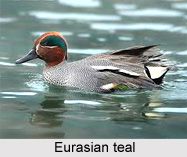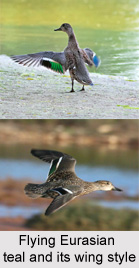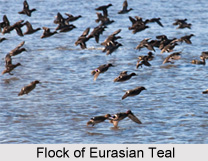Eurasian Teal also known as common teal is an Indian bird with a scientific name "Anas crecca" is a common and widespread duck which breeds in temperate Eura sia and migrates south in winter.
sia and migrates south in winter.
Eurasian Teal is simply the teal due to being the only one of these small dabbling ducks in much of its range. The bird gives its name to the blue-green colour teal.
Concentration of Eurasian Teal
Eurasian Teal is a highly gregarious duck outside the breeding season and can form large flocks. It is commonly found in sheltered wetlands and feeds on seeds and aquatic invertebrates. The North American green-winged teal was formerly considered a subspecies of A. Crecca.
Structure of Eurasian Teal
Eurasian Teal is the smallest extant dabbling duck at 20-30 cm length and with an average weight of 340 g in drake (males) and 320 g in hens, the females. The wings are 17.5-20.4 cm long, yielding a wingspan of 53-59 cm. The bill of Eurasian Teal measures 3.2-4 cm in length, and the tarsus 2.8-3.4 cm.

Colour of Eurasian Teal
Eurasian Teal drakes in nuptial plumage appear grey, with a dark head, a yellowish behind, and a white stripe running along the flanks. The head and upper neck of Eurasian teal is chestnut, with a wide and iridescent dark green patch of half-moon or teardrop-shape that starts immediately before the eye and arcs to the upper hind neck. The patch is bordered with thin yellowish-white lines, and a single line of that colour extends from the patch`s forward end, curving along the base of the bill. The breast is buff with small round brown spots. The centre of the belly is white, and the rest of the body plumage is mostly white with thin and dense blackish vermiculations, appearing medium grey even at a short distance. The outer scapular feathers are white, with a black border to the outer vanes, and form the white side-stripe when the bird is in resting position. The primary remiges are dark greyish brown; the speculum feathers are iridescent blackish-green with white tips, and form the speculum together with the yellowish-white tips of the larger upperwing coverts. The under wing is whitish, with grey remiges, dense dark spotting on the inner coverts and a dark leading edge. The tail and tail coverts are black, with a bright yellowish-buff triangular patch in the centre of the coverts at each side.
Similarity with Hens
In non-breeding plumage, the drake looks more like the hen; it is more uniform in colour, with a dark head and vestigial facial markings. The hen itself is yellowish-brown, somewhat darker on wings and back. It has a dark greyish-brown upper head, hindneck, eyestripe and feather pattern. The pattern is dense short streaks on the head and neck, and scaly spots on the rest of the body; overall they look much like a tiny mallard hen when at rest. The wings are coloured similar to the drake`s, but with brown instead of grey upper wing coverts that have less wide tips, and wider tips of the speculum feathers. The hen`s rectrices have yellowish-white tips; the mid belly is whitish with some dark streaking.
Immatures are coloured much like hens, but have a stronger pattern. The downy young are coloured like in other dabbling ducks: brown above and yellow below, with a yellow supercilium. They are recognizable by their tiny size however, weighing just 15 gram at hatching.

Structure of the Bill
The bill of Eurasian teal is dark grey, in eclipse plumage often with some light greenish or brownish hue at the base. The bill of hens and immatures is pinkish or yellowish at the base, becoming dark grey towards the tip; the grey expands basewards as the bird ages. The feet are dark grey in males and greyish olive or greyish-brown in females and immatures. The iris is always brown.
Sounds of Eurasian Teal
Eurasian teal is a noisy species. The male whistles cryc or creelycc, not loud but very clear and far-carrying. The female has a feeble keh or neeh quack. Males in nuptial plumage are distinguished from green-winged teals by the horizontal white scapular stripe, the lack of a vertical white bar at the breast sides, and the quite conspicuous light outlines of the face patch, which are indistinct in the green-winged teal drake. Males in eclipse plumage, females and immatures are best recognised by their small size, calls, and the speculum; they are hard to tell apart from the green-winged teal however.



















